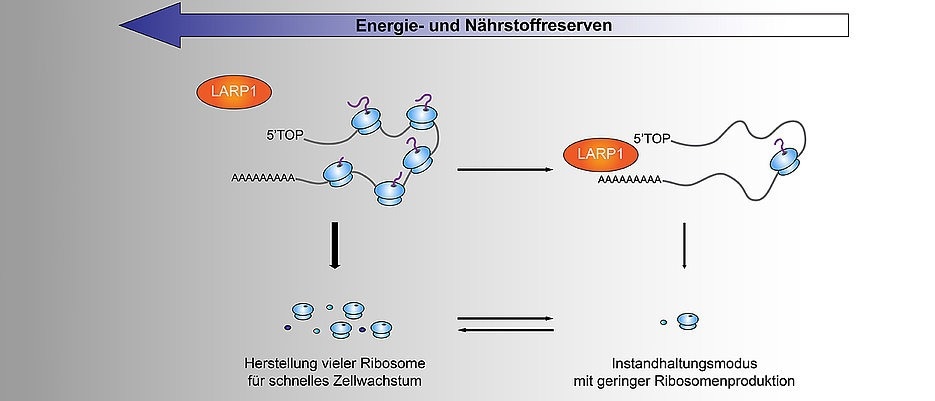Growth is a fundamental element of all life on this planet, whether it be a mammal, a single-celled organism, a plankton, or a sequoia. And the cell is usually where this growth begins; for this to occur, it must rapidly double its constituent parts and ingredients before it can divide and initiate development.
 Cells probably require up to 50 percent of their energy reserves for ribosome production. Under nutrient deficiency, the LARP1 protein ensures that protein production is reduced. Image Credit: Cornelius Schneider
Cells probably require up to 50 percent of their energy reserves for ribosome production. Under nutrient deficiency, the LARP1 protein ensures that protein production is reduced. Image Credit: Cornelius Schneider
The mechanism behind this is intricate and has not yet been fully understood. But now, a Würzburg research team has been successful in pinpointing a crucial mechanism in this procedure.
In the most recent volume of the journal Cell Reports, professors Utz Fischer from the Julius Maximilian University of Würzburg (JMU) Biocentre and Jörg Vogel from the Würzburg Helmholtz Institute for RNA-based Infection Research (HIRI) publish the findings of their research.
Ribosomes deliver new proteins
In order for cells to grow, they have to produce lots of new proteins. This happens inside the cell in specialized factories called ribosomes.”
Utz Fischer, Chair, Biochemistry, Julius Maximilian University of Würzburg
Every human cell has up to 10 million ribosomes devoted to this function. As a result, cells devote a significant portion of their resources and energy reserves to the synthesis of ribosomes, which are important for the manufacturing of proteins.
The “most expensive” activity in the cell, ribosome manufacturing is estimated to consume up to 50% of the cellular energy reserve.
Obviously, the cell cannot sustain such excessive energy and raw material consumption. As a result, it constantly checks its surroundings to make sure that there are always enough nutrients and other growth-promoting factors accessible.
When the “supply situation” worsens, it stops growing and stops making new ribosomes, but it still keeps a sufficient number of ribosomes on hand to be able to expand again right away when conditions are better.
A signaling complex is the central command center
The mTORC1 signaling complex, a type of cellular nutrient sensor, serves as the process’ main control point.
All information on the availability of nutrients and other growth stimuli converges at this signaling complex.”
Dr Cornelius Schneider, Study First Author and Chair, Biochemistry, Julius Maximilian University of Würzburg
According to this information, mTORC1 regulates the synthesis of ribosomal proteins and coordinates the cellular response to altering environmental conditions. It uses assistance from another protein, LARP1, as the researchers were able to demonstrate.
Schneider explained, “mTORC1 can influence the LARP1 protein in such a way that, under nutrient deficiency, it binds to a signal sequence located at the beginning of the mRNAs of all ribosomal proteins. This leads to a reduction in protein production.”
In a metaphorical sense, mRNAs act as the carriers of protein blueprints from the cell nucleus to the ribosomes.
A basic supply always remains
Ribosomal protein synthesis is never totally stopped, even though it is decreased to the barest minimum.
“This means that the cell can start producing large quantities of ribosomes again at any time. This enables it to react extremely quickly to changing conditions and to switch from growth to energy saving,” Fischer added.
This makes it possible for the cell to consistently preserve, even in challenging circumstances, a certain basic supply of mRNAs for the ribosomal proteins.
This is consistent with another finding: different forms of cancer exhibit altered LARP1 and the signaling network surrounding mTORC1, which is at the core of the choice for or against cell proliferation.
Source:
Journal reference:
Schneider, C., et al. (2022). An unusual mode of baseline translation adjusts cellular protein synthesis capacity to metabolic needs. Cell Reports. doi.org/10.1016/j.celrep.2022.111467